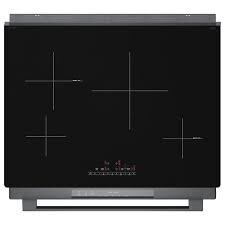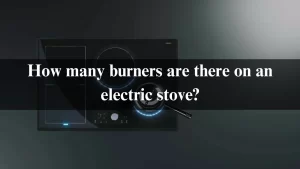Choosing the best induction stoves can seem like a daunting task, especially with all the new models and features coming in 2024. Best Induction stoves are known for their fast cooking, precise control, and stylish look, but with so many options available, how do you pick the best one for your kitchen?
Imagine cooking with a stove that makes your life easier, looks great, and fits your budget. Picking the wrong stove could lead to cooking issues or wasting money on something you don’t love.
In this guide, we’ll discuss the latest advancements and features in induction stoves and give you clear tips on what to look for. Whether you’re an experienced cook or just looking to upgrade, we’ll help you find the best induction stoves to make your kitchen experience amazing.
Table of Contents
Why did we choose an induction stove?
Induction stoves are chosen for their efficiency. They heat up faster and use less energy by directly heating the pot or pan. They are up to three times more efficient than gas stoves and up to 10% more efficient than conventional smooth-top electric ranges, which can result in lower energy costs and reduced air pollution. Best Induction stoves offer precise temperature control, are safer with a cool-to-the-touch cooktop, have an easy-to-clean flat surface, and provide consistent, even heat distribution for improved cooking results.
How do I know what size stove I need?
Some people need clarification about selecting the best induction stoves size for their home and kitchen. So, don’t worry about it. I will let you know simply and easily to determine the size of the induction stove before buying it. To determine the correct size stove for your needs, consider the following:
- Available Space: Measure the area where the stove will be installed, including width, depth, and height.
- Cooking Needs: Choose a stove with enough burners or cooking zones based on how many dishes you usually prepare simultaneously.
- Household Size: Larger households or those who frequently entertain may need a stove with more burners and a larger oven capacity.
- Oven Capacity: A common rule is about 1 cu. ft. per person. For example, a stove with an oven capacity of 2 cu. ft. works well for one or two people, while a 5 cu. ft. oven or larger is better for larger households or those who entertain often.
- Style Preference: Decide between freestanding, slide-in, or built-in models based on your kitchen design.
- Features: Consider additional features like double ovens or extra-large cooking zones if they align with your cooking habits
I always prefer that you look at these key points to determine the size of an induction stove before buying it.
What are two factors to consider when buying a stove?
When buying a stove, consider:
- Cooking Needs: Assess the number and type of burners or cooking zones you need and factor in the oven capacity based on household size.
- Size: Consider both the stove’s dimensions and heat output. Larger rooms may require higher kilowatt outputs. Ensure the stove fits your space and complies with building regulations regarding placement, flue, and hearth size. Also, plan for space around the stove and check for any smoke control area requirements.
These factors help ensure you choose a stove that fits your kitchen and cooking habits while meeting safety and regulatory standards.
Top 16 features you must know before buying an induction stove?
There are some features of a stove. When you buy an induction stove, you need to focus on these features. I have mentioned some features below;
- Power Levels: Look for models with adjustable power settings for precise cooking control. Higher kilowatt ratings offer more heat output, which is crucial for cooking efficiency. Ensure the stove’s heat output matches your room size and cooking needs.
- Size and Dimensions: Check the stove’s physical dimensions and cooking zones to ensure it fits your kitchen space and meets your cooking requirements.
- Control Panel: Choose an intuitive interface, such as touch controls or knobs, for ease of use.
- Boost Function: Allows for rapid heating to speed up cooking times.
- Timer Function: Enables setting cooking times and automatic shut-off.
- Safety Features: Look for child locks, automatic shut-off, and overheat protection.
- Ease of Cleaning: A smooth, flat surface should be easy to wipe down.
- Compatibility: Ensure your cookware is compatible with induction cooking (magnetic base).
- Smart Features: Some models offer app connectivity for remote control and monitoring.
- Building Regulations: Ensure compliance with local regulations regarding space around the stove, flue placement, and hearth size.
- Location: Plan placement to allow space between the stove and combustible materials. Consider the manufacturer’s guidelines for clearance.
- Smoke-Controlled Areas: If you live in a smoke-controlled area, choose a stove approved for such use, such as a DEFRA-approved model.
- Chimney: Ensure you have a suitable chimney or plan for a twin wall flue system if you need a different one.
- Fuel Type: If you live in a smoke-controlled area, decide between wood, smokeless fuels, or a multifuel stove.
- Budget: Balance your budget with the stove’s features and quality. Options are available across a range of prices.
- Brand and Style: Choose between traditional or contemporary styles and decide on a brand. While well-known brands may cost more, lesser-known brands can offer high quality at lower prices.

After reading this blog post, you can find the perfect cooktop for your kitchen.
6 Things that I love in induction cooking
As you know, my experience with induction cooking is outstanding. But I will tell you how these things make me experience excellent induction cooking. Which I have mentioned below;
- Speed: The induction burners are high-speed. I’ve been amazed at how quickly water boils now—something that used to take forever.
- Dreamy Cleanup: Gone are the days of scrubbing crumbs and spills from stovetop cracks. A few gentle swipes with a soft sponge keep the surface looking new.
- Breathe Easier: Induction cooking improves air quality in the kitchen compared to gas. I noticed less drop in air quality with induction and no significant issues with our air filter.

- Steady Simmer: Induction burners excel at maintaining a low simmer, providing precise control that gas burners often lack.
- Suitable Oven Modes: The Bertazzoni oven offers proper modes like “bottom bake” and “top bake,” which help manage heat distribution for better baking results. The oven light also works well for proofing dough.
- Durable: The Bertazzoni oven has proven to be robust. Despite a minor accident where a hot cast iron lid hit the oven door glass, it didn’t shatter.
I’ll continue to add to this list as my experience with induction cooking develops. These are my thoughts after about three months of daily use.
9 Things that I don’t love about my induction stove;
- Cookware Compatibility: Only magnetic cookware works, so I had to invest in new pots and pans.
- Noise: Some induction stoves make a humming or buzzing noise, particularly at higher power levels.
- Cost: Induction stoves are generally more expensive than gas or electric models.
- Learning Curve: Adjusting to touch controls and features took time and patience.
- Focused Burner Intensity: The intense and concentrated heat can scorch or burn ingredients if they extend beyond the burner element.
- 220v Power Requirement: Installing a 220v outlet was an additional expense, though this is not unique to induction stoves.
- Bad Popcorn: I need help burning popcorn, even in lower settings.
- Cooking on Glass: Keeping pans in direct contact with the glass surface is challenging, affecting heat retention. I’m adjusting to a quieter cooking style with less pan movement.
- Pots & Pans: Not all cookware is suitable for induction. While some pans, like carbon steel, work well, others, such as my largest All-Clad skillet, haven’t performed as well.
You can see the Bertazzoni being installed above. I was initially nervous about switching from gas to induction, but the stove has performed reliably since installation. Despite these challenges, I’m continuing to adjust and will share more insights on cookware in future posts.
Top 8 Best Brands of Best Induction Stoves?
There are many brands worldwide from which you can buy best induction stoves. Each brand has its specifications. I will let you know the top 8 brands of induction stoves. These are mentioned below;
- Bosch: Known for high reliability and readily available parts.

- Miele: Premium features and performance.
- Samsung: Modern technology and smart features.
- Wolf: Professional-grade appliances.
- KitchenAid: Durable and well-designed.
- Bertazzoni: Stylish and reliable.
- Fisher & Paykel: Innovative and user-friendly.
- Electrolux: Efficient and high-performing.
- General Advice:
- Price Range: Expect a wide range of prices from $300-$500 for lesser-known brands to $850 and up for more prominent, reputable brands.
- Parts Availability: Ensure parts are readily available and easily purchasable. Bosch, Thermador, and Gaggenau are excellent in this regard.
- Testing Controls: It’s advisable to try the controls in person to ensure they meet your preferences.
- Performance: Investing in a reputable brand can offer better performance, especially for high-heat and low-heat cooking. Lower-priced models may deliver a different quality, particularly with larger cookware.
- Reliability: Be cautious with cheaper models, which may have higher repair costs and limited features. Well-known brands with good reliability records are often a safer choice.
Personal Experience:
- GE Induction Cooktop: This was chosen for its ease of control and positive feedback on performance. Transitioning from gas to induction has been satisfactory.

- Frigidaire Gallery: A cautionary note was given about reliability issues with this model, leading to dissatisfaction and a possible return to a regular cooktop.
- Electrolux: Has been a good performer since 2008; ensures cookware is compatible with induction.
What is the best induction stove for the latest year, 2024?
As you know, many kinds of induction stoves have been introduced. But If you still need clarification in 2024 about buying the best induction stoves. Don’t worry. I will let you know some of the best induction stivovesFor 2024, which include;
- Bosch 800 Series NIT8069UC
- Features: FlexInduction, AutoChef, and 17 power levels.
- Why It’s Great: Excellent build quality, advanced features, and consistent performance.
- Miele KM 7697
- Features: PerfectClean surface, PowerFlex, and various cooking modes.
- Why It’s Great: Premium build, advanced technology, and exceptional ease of cleaning.
- Samsung NZ36K7880UG
- Features: Virtual Flame Technology, FlexZone, and Wi-Fi connectivity.
- Why It’s Great: Innovative features, user-friendly interface, and intelligent capabilities.
- Wolf CI365C/B
- Features: Four induction elements, performance boost, and precise controls.
- Why It’s Great: Professional-grade performance, durability, and precision.
- KitchenAid KICU509XSS
- Features: Even-Heat technology, bridge element, and easy-to-use controls.
- Why It’s Great: Reliable performance, even heating, and versatility.
- Electrolux EI36IC60LS
- Features: Perfect Pair, PowerBoost, and intuitive controls.
- Why It’s Great: High efficiency, responsive controls, and modern design.
These models are noted for their advanced features, reliability, and performance. Always check the latest reviews and specifications to ensure the model meets your needs.
How much should I pay for an induction stove?
Among the 90 people who responded to our survey, the average cost of an induction stove was $2,231. Prices ranged from $600 to $9,200, with only four stoves costing more than $4,000. This reflects a broad range of options depending on your chosen features and brand.
You Can Also Read: Choosing The Right Induction Cooktop For Your Kitchen 2024
Conclusion
Choosing the best induction stoves involves considering efficiency, size, features, and cost. Best Induction stoves are favoured for their rapid heating, energy efficiency, precise temperature control, and ease of cleaning. To select the right size, measure your available space, assess your cooking needs, and consider household size and oven capacity. Key factors when buying include cooking needs, stove size, power levels, control panels, safety features, and compatibility with cookware.
For 2024, top best induction stoves include the Bosch 800 Series, Miele KM 7697, Samsung NZ36K7880UG, Wolf CI365C/B, KitchenAid KICU509XSS, and Electrolux EI36IC60LS. Prices can vary widely, with an average cost of $2,231 among survey respondents, ranging from $600 to $9,200. Investing in a reputable brand often ensures better performance and reliability while considering parts availability and warranty support.
FAQs
Do induction stoves use a lot of electricity?
Induction stoves are energy-efficient, often using less electricity than traditional electric stoves due to their direct heat transfer.
Can I use regular pans on an induction stove?
No, only induction-compatible cookware, usually made from magnetic materials like cast iron or stainless steel, will work.
Are induction stoves safe for households with children?
Yes, the cooktop remains cool to the touch, and many models have child-lock features, making them safer for homes with children.
What are the common problems with induction stoves?
Issues like incompatibility with cookware, glass scratches, or electrical requirements can be common, but they are easily avoidable with proper care




